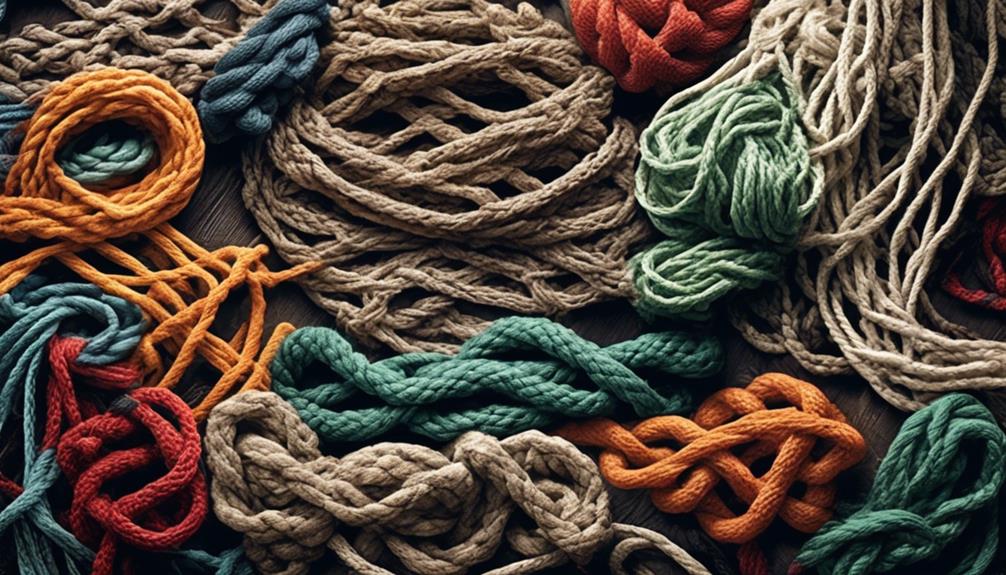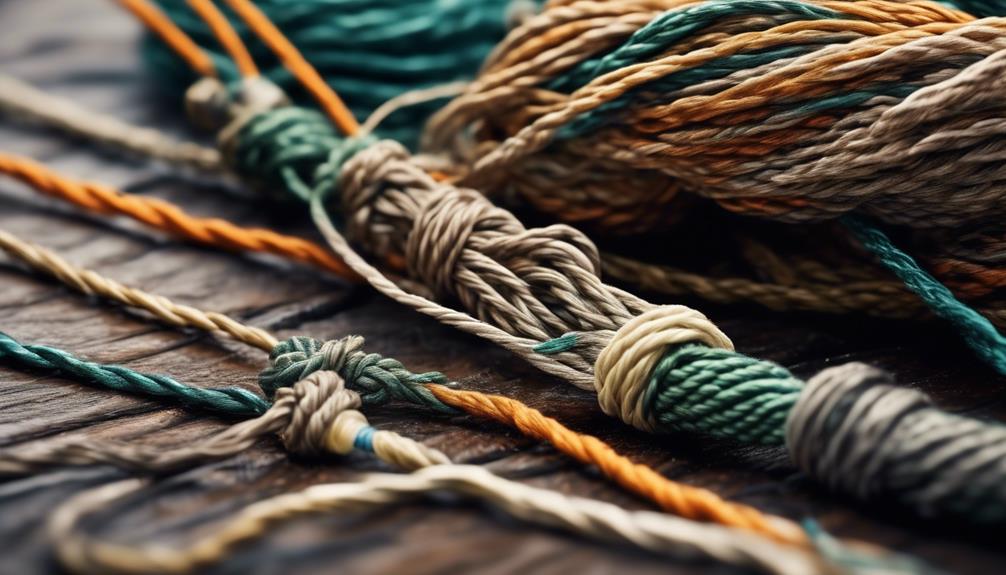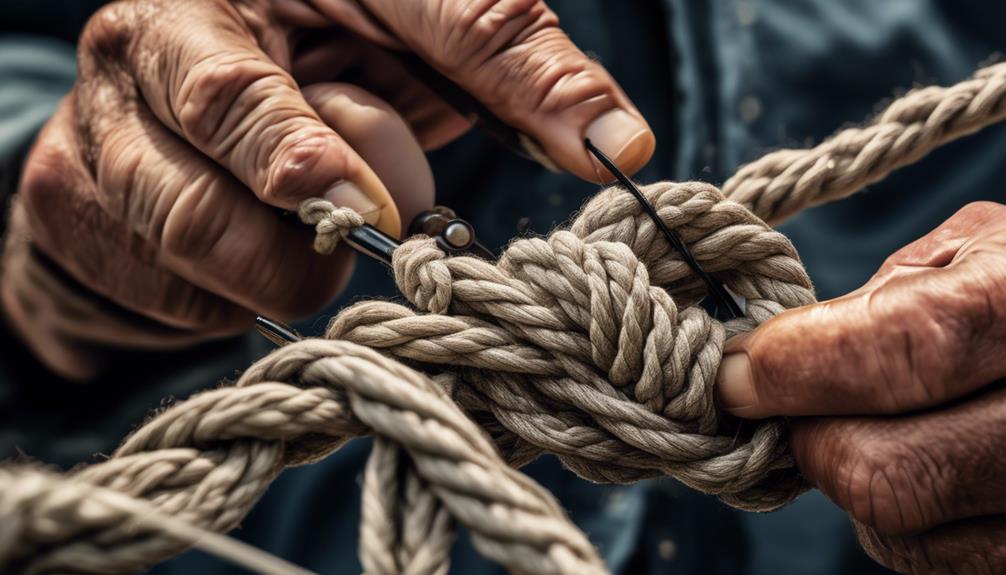Looking to elevate your fishing net game? Wondering which slip knots are best for ensuring efficiency and reliability? Look no further.
With so many options out there, it can be overwhelming to choose the right knot for your fishing net. But fear not, as we've compiled a list of the six best slip knots that are sure to make your fishing experience smoother and more productive.
Stay tuned to discover how these knots can make a significant difference in your fishing endeavors.
Uni Knot
To tie a strong and reliable knot for your fishing net, the Uni Knot is a versatile and essential technique. This knot is advantageous because of its strength and adaptability. It can be used in various fishing scenarios, such as attaching hooks, swivels, and lures, making it a valuable skill for any angler.
The Uni Knot also retains a significant amount of the line's original strength when tied correctly, which is crucial when dealing with large or powerful fish. Its main disadvantage, however, is that it can be challenging to tie correctly at first, especially with heavier lines. Nevertheless, with practice, you can efficiently tie the Uni Knot with ease.
To tie the Uni Knot efficiently, start by threading the line through the eye of the hook and double it back, forming a loop. Then, make 4-6 wraps around the doubled line, ensuring that the wraps are neat and parallel to each other. After completing the wraps, moisten the knot and pull the tag end to tighten the wraps. Once the knot is snug, slide it down to the eye of the hook and pull both the main line and the tag end to secure the knot firmly. Trim the tag end, leaving a small amount to prevent the knot from slipping.
With perseverance and patience, you'll master the Uni Knot, adding a valuable knot-tying skill to your fishing repertoire.
Palomar Knot
Wondering which knot can provide a strong and reliable hold for your fishing net? Look no further than the Palomar knot. This knot is known for its exceptional strength and is a popular choice among anglers for securing fishing nets. The Palomar knot is easy to tie and is highly effective in maintaining the integrity of the net, making it a valuable skill for any fishing enthusiast.
One of the key advantages of the Palomar knot is its remarkable strength. It's capable of withstanding heavy loads and is particularly well-suited for fishing nets that need to endure significant tension and weight. This knot's ability to maintain its integrity under pressure makes it an ideal choice for securing fishing nets, providing peace of mind when casting the net into the water.
Tying the Palomar knot involves simple yet effective techniques. To begin, double the fishing net line and pass it through the eye of the net. Next, tie an overhand knot with the doubled line, creating a loop large enough to pass the net through. Then, carefully pass the net through the loop and pull both ends of the line to tighten the knot. Finally, trim any excess line for a clean finish.
With practice, mastering the Palomar knot tying technique will become second nature, ensuring a secure and reliable hold for your fishing net.
Improved Clinch Knot
If you need an alternative knot for securing your fishing net, the Improved Clinch Knot offers a reliable and secure hold, complementing the strength of the Palomar knot. When it comes to fishing line strength, the Improved Clinch Knot is a top choice for many anglers. This classic knot is known for its simplicity and effectiveness, making it a valuable skill for any fisherman. The Improved Clinch Knot is versatile and can be used with various types of fishing lines, including monofilament and fluorocarbon.
Learning proper knot tying techniques is essential for any angler, and mastering the Improved Clinch Knot is a great place to start. To tie the Improved Clinch Knot, begin by threading the line through the eye of the hook and then make 5 to 7 wraps around the line. After that, thread the end of the line through the loop closest to the eye of the hook and then through the larger loop. Moisten the knot and pull both ends of the line to secure the knot in place.
The Improved Clinch Knot isn't only useful for securing hooks but also has applications for creating loop knots. This makes it a versatile knot that can be used for various fishing techniques. Whether you're a beginner or a seasoned angler, mastering the Improved Clinch Knot is a valuable skill that will serve you well on the water.
Non-Slip Loop Knot
The Non-Slip Loop Knot, also known as the 'Kreh Loop,' provides a secure and reliable method for creating a loop at the end of a line for lures or hooks. This knot is highly valued for its non slip loop knot strength, making it an excellent choice for applications where a strong and secure loop is essential.
- Fishing Lures: The Non-Slip Loop Knot is commonly used for attaching fishing lures as it allows for natural and unrestricted movement, enhancing the presentation of the lure to potential catches.
- Live Bait: When using live bait, this knot ensures that the bait moves freely, mimicking natural movement and increasing the likelihood of attracting fish.
- Heavy-Duty Fishing: For heavy-duty fishing applications, such as deep-sea fishing or targeting larger fish species, the non slip loop knot strength is crucial for withstanding the powerful forces exerted by big catches.
- Quick and Efficient: This knot is quick and easy to tie, making it an efficient choice for anglers looking to spend more time fishing and less time retying knots.
- Versatile: Its versatility allows for a wide range of fishing techniques and styles, from freshwater to saltwater fishing, making it a go-to knot for anglers in various environments.
Perfection Loop
The Perfection Loop is a versatile and reliable knot used in fishing and other outdoor activities for creating a secure loop at the end of a line. When it comes to fishing nets, the Perfection Loop offers several benefits. Its non-slip design ensures that the loop retains its strength and shape, making it ideal for securing the ends of a fishing net. This knot also allows the net to move freely, which is essential for efficient fishing.
To tie the perfect Perfection Loop for fishing nets, start by forming a small loop at the end of the line. Then, bring the tag end behind the standing line and pass it through the small loop. Ensure that the tag end travels parallel to the standing line. Next, make another loop with the tag end, wrapping it over the standing line and through the small loop. Moisten the knot before pulling the tag end and the standing line simultaneously to tighten the loop. Finally, trim any excess line to complete the Perfection Loop.
When tying the Perfection Loop, keep the loops and wraps smooth and even to maintain the knot's strength. Practice tying the knot multiple times to ensure you can do it quickly and efficiently while out on the water.
With these tips in mind, you can confidently use the Perfection Loop to secure your fishing nets and enhance your fishing experience.
Double Surgeon's Loop
When mastering the Perfection Loop for your fishing nets, you can further expand your knot repertoire by learning the Double Surgeon's Loop. The Double Surgeon's Loop offers several advantages for fishing nets, making it a valuable addition to your skill set. To tie this knot, simply follow these techniques:
Advantages of double surgeon's loop:
- Strength: The Double Surgeon's Loop is known for its exceptional strength, ensuring that your fishing net remains secure even when dealing with larger catches.
- Easy to Tie: This knot is relatively easy to tie, making it a convenient choice for anglers of all skill levels.
- Versatility: It can be used to create a secure loop at the end of a line, which is particularly useful for attaching hooks, swivels, or sinkers to your fishing net.
- Reliability: The Double Surgeon's Loop is highly reliable, reducing the risk of slippage or failure when under pressure.
- Time-Efficient: Once mastered, this knot can be tied quickly, allowing you to spend more time fishing and less time dealing with complicated knots.
Figure 8 Loop

To create a secure loop at the end of a line for your fishing net, consider using the Figure 8 Loop, a reliable knot with various practical applications.
The Figure 8 Loop is highly beneficial for fishing nets due to its strength and security. This knot maintains almost the full breaking strength of the line, making it suitable for handling the tension and weight of a loaded fishing net.
One of the key advantages of the Figure 8 Loop in fishing nets is its ability to maintain its integrity even when subjected to heavy loads, ensuring that your fishing net remains securely attached to the line.
When tying a secure Figure 8 Loop for your fishing net, start by forming a small loop at the end of the line. Then, bring the tag end of the line around and cross over the standing line to form an 'S' shape.
Next, pass the tag end through the loop from the underside and thread it down through the top of the 'S' shape. Ensure that the knot is dressed neatly and tightened carefully to prevent any slippage or weakening of the loop.
Additionally, always leave sufficient tag end to prevent the knot from unraveling.
Bowline Loop
You can create a secure and versatile loop for your fishing net by learning to tie the Bowline Loop knot. The Bowline Loop knot is a valuable tool for fishing nets due to its reliability, strength, and ease of untying, making it a popular choice among fishermen.
Here are some advantages and applications of the Bowline Loop in fishing nets:
- Strength: The Bowline Loop is known for its strength, making it ideal for securing fishing nets and withstanding the tension and weight of the catch.
- Versatility: This knot can be easily adjusted to fit different sizes of fishing nets, allowing for flexibility in various fishing conditions.
- Reliability: The Bowline Loop maintains its integrity even when subjected to constant tension, ensuring that your fishing net remains secure during use.
- Ease of Untying: Despite its secure hold, the Bowline Loop is relatively easy to untie after use, saving time and effort for fishermen.
- Applications: The Bowline Loop is commonly used to create a loop at the end of a rope, making it perfect for attaching fishing nets to buoys, anchors, or other essential components of a fishing setup.
Frequently Asked Questions
What Are the Best Types of Fishing Nets to Use With These Different Knots?
When fishing, securing your catch is crucial. Using the best slip knots and knot combinations is key. Consider the fishing net materials and their strength when choosing the right knots.
Ensure the knots are secure to prevent any mishaps. Different knot combinations work well with various fishing nets, so experiment to find the most efficient option.
Can These Knots Be Used With Any Type of Fishing Line, or Are There Specific Types They Work Best With?
Yes, these knots can be used with any type of fishing line. However, some types may work best with certain knots. Pay attention to fishing line compatibility and knot strength for secure connections.
Practice knot tying techniques to ensure a strong and secure hold. This is especially important when using different types of fishing lines. With the right technique, these knots can create secure connections regardless of the type of fishing line used.
Are There Any Specific Techniques or Tips for Tying These Knots in a Way That Ensures They Are Secure and Won't Come Undone?
When tying slip knots, it's important to use proper techniques and security measures to ensure they stay secure. Make sure to tighten the knot properly and test its security before using it.
Also, consider the type of fishing line you're using and adjust your tying technique accordingly. Adding extra loops or twists can also enhance the security of the knot.
Practicing these techniques will help you tie more secure slip knots for your fishing nets.
Are There Any Common Mistakes or Pitfalls to Avoid When Using These Knots With Fishing Nets?
When using slip knots with fishing nets, common mistakes can lead to frustrating tangles. To avoid pitfalls, ensure you're using the proper technique for securing the knots.
Check that the tension is just right to prevent slippage. Also, be mindful of the type and thickness of the rope you're using, as this can affect the security of the knot.
Paying attention to these details will help ensure your fishing net stays secure.
Can These Knots Be Used in Combination With Each Other to Create Even Stronger and More Secure Connections in Fishing Nets?
Yes, you can definitely use a combination of slip knots to enhance the strength and security of your fishing nets.
When it comes to knot combination, it's all about finding the right mix to maximize strength and durability.
By incorporating multiple knots strategically, you can create a more secure and reliable connection in your fishing nets.
This approach not only enhances the strength but also ensures better security measures for your nets.
Conclusion
So there you have it – the 6 best slip knots for efficient fishing nets. Whether you're a seasoned angler or just starting out, these knots will help you secure your net and improve your chances of a successful catch.
With a little practice, you'll be able to tie these knots quickly and confidently, ensuring that your fishing net is always ready for action.
Happy fishing!



